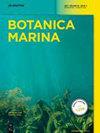基于形态学和分子数据的墨西哥大西洋海藻新种:Gelidium rodrigueziae sp.
IF 1.4
4区 生物学
Q2 MARINE & FRESHWATER BIOLOGY
引用次数: 0
摘要
Gelidium 属藻类经常栖息在墨西哥大西洋的潮间带岩石中,数量丰富。据报道,该地区有六种该属的藻类,但只有 Gelidium americanum 通过形态学和分子工具得到了确认,尽管这两种工具对该类藻类来说非常重要。这项研究的目的是利用 rbcL 和 COI-5P 标记,通过形态学和分子方法对之前被鉴定为 Gelidium 的墨西哥标本进行评估。这项研究考察了在墨西哥大西洋中高潮间带发现的附着在腹足类动物 Stramonita rustica 外壳上的 20 个标本和在岩石上发现的 10 个标本。系统发生学分析表明,这些标本是一个独立的物种,与 G. gonzalezii、G. yangmeikengense 和 G. indonesianum 关系密切。遗传距离和形态学信息证实了这一点。Gelidium rodrigueziae sp.它与相关物种的区别在于其分枝模式更简单、髓细胞的数量和大小更小、髓周围限制性内部根状细丝的数量和分布更少。本文章由计算机程序翻译,如有差异,请以英文原文为准。
A new species of marine algae from the Mexican Atlantic based on morphology and molecular data: Gelidium rodrigueziae sp. nov. (Gelidiaceae, Rhodophyta)
The algae of the genus Gelidium can be found as frequent and abundant inhabitants in the rocky intertidal zone of the Mexican Atlantic. Six species of this genus have been reported in this region, but only Gelidium americanum has been confirmed with morphological and molecular tools, despite how important both tools have proven to be for the group. This research aimed to evaluate the Mexican specimens previously identified as Gelidium through morphological and molecular approaches, using rbc L and COI-5P markers. This study examined 20 specimens found living attached to the shell of a gastropod Stramonita rustica in the mid-high intertidal zone of the Mexican Atlantic and ten specimens found living on rocks. Phylogenetic analyses resolved these specimens to be an independent species closely related to G. gonzalezii , G. yangmeikengense , and G. indonesianum . Genetic distances and morphological information confirmed this. Gelidium rodrigueziae sp. nov. is described as a new species. It is distinguished from its related species by having a simpler branching pattern, a smaller number and size of medullary cells, and the smaller quantity and distribution of restricted internal rhizoid filaments around the medulla.
求助全文
通过发布文献求助,成功后即可免费获取论文全文。
去求助
来源期刊

Botanica Marina
生物-海洋与淡水生物学
CiteScore
4.10
自引率
4.50%
发文量
43
期刊介绍:
Botanica Marina publishes high-quality contributions from all of the disciplines of marine botany at all levels of biological organisation from subcellular to ecosystem: chemistry and applications, genomics, physiology and ecology, phylogeny and biogeography. Research involving global or interdisciplinary interest is especially welcome. Applied science papers are appreciated, particularly when they illustrate the application of emerging conceptual issues or promote developing technologies. The journal invites state-of-the art reviews dealing with recent developments in marine botany.
 求助内容:
求助内容: 应助结果提醒方式:
应助结果提醒方式:


